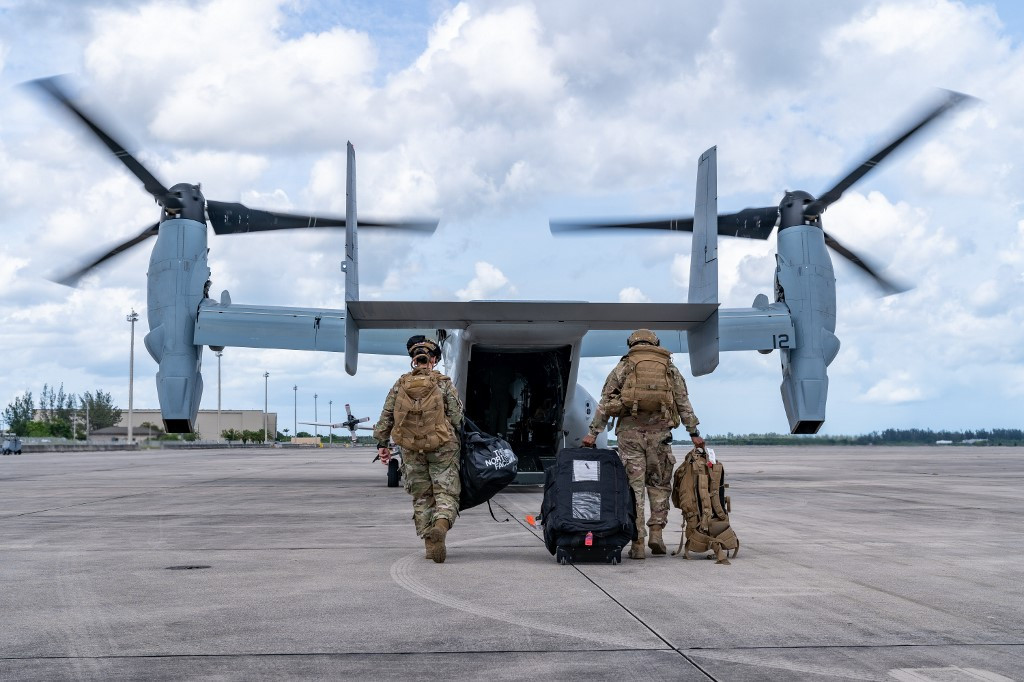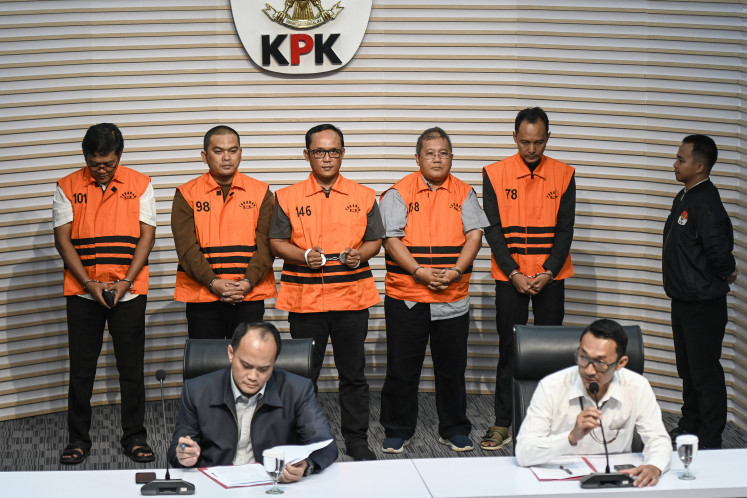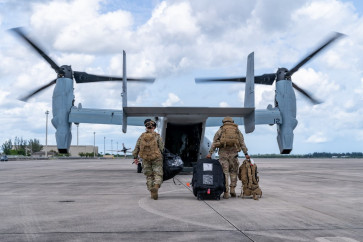Popular Reads
Top Results
Can't find what you're looking for?
View all search resultsPopular Reads
Top Results
Can't find what you're looking for?
View all search resultsOsprey in the archipelago: The deal of MV-22 to Indonesia
Eclipsed by larger projects, such as F-16V fighters, the MV-22 deal may not stand out, but it symbolizes an attempt of the Indonesian armed forces to explore a new capability to supplement the existing ones.
Change text size
Gift Premium Articles
to Anyone
 Airmen from the United States Air Force's Crisis Response Group board a Marine Corps MV-22 Osprey from the Navy's USS Bataan at Homestead Air Reserve Base, Florida, on Sept. 4, 2019, in support of Foreign Disaster Relief efforts in The Bahamas. (Agence France Presse/Technical Sgt. Lionel Castellano / DoD / AFP)
Airmen from the United States Air Force's Crisis Response Group board a Marine Corps MV-22 Osprey from the Navy's USS Bataan at Homestead Air Reserve Base, Florida, on Sept. 4, 2019, in support of Foreign Disaster Relief efforts in The Bahamas. (Agence France Presse/Technical Sgt. Lionel Castellano / DoD / AFP)
T
he recently announced deal of eight MV-22 Osprey tilt-rotor aircraft to Indonesia, the first in Southeast Asia, signifies an attempt to improve its airlift capability with certain challenges ahead.
The Indonesian archipelago of more than 17,500 islands represents a significant demand for military airlift, especially for time-sensitive missions, such as disaster relief, search and rescue. Regarding the demand for airlift, the Indonesian armed forces have established certain capacities, and its indigenous aerial industry has become an important supplier for rotary and fixed-wing transport aircraft. However, there is a gap between fixed-winged and rotary airlift in terms of speed.
The fixed-winged aircraft is faster than its rotary counterpart but airfields or at least a certain size of flat ground is indispensable. Although most models of transporter aircraft in the Indonesian service, from C-130 to NC-212, are capable of short take-off and landing (STOL) to accept airfields with poor conditions, there are still many areas unsuitable for them, except airdrop with parachutes.
This constraint is crucial for the largest archipelagic country, as it is impossible to make airstrips available on every island, despite the governmental effort in infrastructure. In contrast, helicopters with the vertical take-off and landing (VTOL) capability are convenient to reach most places among the archipelago, but they are relatively slow, and the speed matters in the time-sensitive missions, particularly in Indonesia’s broad territory.
The distribution of helicopters nationwide helps to enhance their coverage over the large Indonesian territory, but there are still some corners in assigned areas where take time for helicopters to reach.
Before the deal of Osprey, Jakarta narrows the gap by acquiring several types of light fixed-wing aircraft for lower demand on runways, such as CN-235, NC-212, and N-219, to broaden their accessible locations, and introduction of the helicopter models with a relatively large payload and long-range, such as Super Puma Family from SA-330 to the latest H-225, for the areas without airstrips.
The main challenge to this arrangement is the speed because the cruise speed of H-215 is about 135 knot (250 km/hr), much slower 237 kt (438 km/hr) of CN-235. In contrast, the MV-22 stands for an alternative better than the current options for its cruise speed of 500 km, faster than CN-235 and other light fixed-wing aircraft, and the radius of 428 nm (792km), longer than CN-235 of 414nm and H-215 of 350 nm.

















